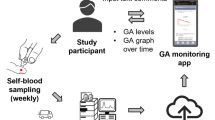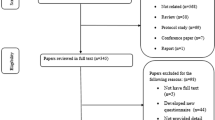Abstract
Heterogeneity of people with diabetes makes maintaining blood glucose control and achieving therapy adherence a challenge. It is fundamental that patients get actively involved in the management of the disease in their living environments. The objective of this paper is to evaluate the use and acceptance of a self-management system for diabetes developed with User Centered Design Principles in community settings. Persons with diabetes and health professionals were involved the design, development and evaluation of the self-management system; which comprised three iterative cycles: scenario definition, user archetype definition and system development. A comprehensive system was developed integrating modules for the management of blood glucose levels, medication, food intake habits, physical activity, diabetes education and messaging. The system was adapted for two types of principal users (personas): Type 1 Diabetes user and Type 2 Diabetes user. The system was evaluated by assessing the use, the compliance, the attractiveness and perceived usefulness in a multicenter randomized pilot study involving 20 patients and 24 treating professionals for a period of four weeks. Usage and compliance of the co-designed system was compared during the first and the last two weeks of the study, showing a significantly improved behaviour of patients towards the system for each of the modules. This resulted in a successful adoption by both type of personas. Only the medication module showed a significantly different use and compliance (p= 0.01) which can be explained by the different therapeutic course of the two types of diabetes. The involvement of patients to make their own decisions and choices form design stages was key for the adoption of a self-management system for diabetes.







Similar content being viewed by others
References
Nolte, E, and McKee, M, Caring for People with Chronic Conditions: A Health System Perspective. UK: McGraw-Hill Education, 2008. ISBN 9780335236909.
Bodenheimer, T, Lorig, K, Holman, H, and Grumbach K, PAtient self-management of chronic disease in primary care. JAMA 288(19):2469–2475, 2002. https://doi.org/10.1001/jama.288.19.2469. ISSN 0098-7484.
American Diabetes Association, Standards of Medical Care in Diabetes—2008. Diabetes Care 31(Supplement 1): S12–S54, 2008. https://doi.org/10.2337/dc08-S012, http://care.diabetesjournals.org/content/31/Supplement_1/S12.
Inzucchi, S E, Bergenstal, R M, Buse, J B, Diamant, M, Ferrannini, E, Nauck, M, Peters, A L, Tsapas, A, Wender, R, and Matthews, D R, Management of hyperglycemia in type 2 Diabetes, 2015: a patient-centered approach: update to a position statement of the American diabetes association and the European association for the study of diabetes. Diabetes Care 38(1):140–149, 2015. https://doi.org/10.2337/dc14-2441. ISSN 19355548.
Zarkogianni, K, Litsa, E, Mitsis, K, Wu, P, Kaddi, C, Cheng, C, Wang, M, and Nikita, K, A review of emerging technologies for the management of diabetes mellitus. IEEE Trans. Bio-Med. Eng. PP(99):1, 2015. https://doi.org/10.1109/TBME.2015.2470521. http://www.ncbi.nlm.nih.gov/pubmed/26292334.
Reutens, A T, Hutchinson, R, Binh, T V, Cockram, C, Deerochanawong, C, Ho, L T, Ji, L, Khalid, B A K, Kong, A P S, Lim-Abrahan, M A, Tan, C E, Tjokroprawiro, A, Yoon, K H, Zmmet, P Z, and Shaw, J E, The GIANT study, a cluster-randomised controlled trial of efficacy of education of doctors about type 2 diabetes mellitus management guidelines in primary care practice. Diabetes Res. Clin. Pract. 98(1): 38–45, 2012. https://doi.org/10.1016/j.diabres.2012.06.002. ISSN 01688227.
Aslan, S., Ciocca, G., and Schettini, R.: Semantic segmentation of food images for automatic dietary monitoring. In: 2018 26th Signal Processing and Communications Applications Conference (SIU), pp. 1–4, 2018, https://doi.org/10.1109/SIU.2018.8404824.
Gómez, E J, Hernando Pérez, M E, Vering, T, Cros, M R, Bott, O, García-Sáez, G, Pretschner, P, Bruguéz, E, Schnell, O, Patte, C, Bergmann, J, Dudde, R, and de Leiva, A, The INCA system: A further step towards a telemedical artificial pancreas. IEEE Trans. Inf. Technol. Biomed. 12(4): 470–479, 2008. https://doi.org/10.1109/TITB.2007.902162. ISSN 10897771.
Martinez-Millana, A, Fico, G, Fernández-Llatas, C, and Traver, V, Performance assessment of a closed-loop system for diabetes management. Med. Biol. Eng. Comput. 53(12):1295–1303, 2015. https://doi.org/10.1007/s11517-015-1245-3. ISSN 1741-0444.
Oreskovic, N M, Maniates, J, Weilburg, J, and Choy, G, Optimizing the use of electronic health records to identify high-risk psychosocial determinants of Health. JMIR Med. Inf. 5 (3): e25, 2017. https://doi.org/10.2196/medinform.8240. http://medinform.jmir.org/2017/3/e25/.
Conte, R., Sansone, F., Grande, A., Tonacci, A., Napoli, F., Pala, A. P., Raciti, M., and Landi, P.: Development of an integrated ict system for data production, standardization and elaboration in health care. In: 2017 E-Health and Bioengineering Conference (EHB). https://doi.org/10.1109/EHB.2017.7995426, pp. 321–324, 2017.
Ryu, B, Kim, N, Heo, E, Yoo, S, Lee, K, Hwang, H, Kim, J.-W., Kim, Y, Lee, J, and Jung, S Y, Impact of an electronic health record-integrated personal health record on patient participation in health care: development and randomized controlled trial of MyHealthKeeper. J. Med. Int. Res. 19(12):e401, 2017. https://doi.org/10.2196/jmir.8867. http://www.jmir.org/2017/12/e401/.
Chavez, S, Fedele, D, Guo, Y, Bernier, A, Smith, M, Warnick, J, and Modave, F, Mobile Apps for the management of diabetes. Diabetes Care 40(10):e145–e146, 2017. https://doi.org/10.2337/dc17-0853. http://care.diabetesjournals.org/lookup/doi/10.2337/dc17-0853.
Irace, C, Schweitzer, M A, Tripolino, C, Scavelli, F B, and Gnasso, A, Diabetes data management system to improve glycemic control in people with type 1 Diabetes: Prospective cohort study. JMIR mHealth uHealth 5(11):e170, 2017. https://doi.org/10.2196/mhealth.8532. http://mhealth.jmir.org/2017/11/e170/.
Helal, A, Cook, D J, and Schmalz, M, Smart home-based health platform for behavioral monitoring and alteration of diabetes patients. J. Diabetes Sci. Technol. 3(1):141–148, 2009. http://www.ncbi.nlm.nih.gov/pmc/articles/PMC2769843/.
Synnott, J, Chen, L, Nugent, C D, and Moore, G: Flexible and customizable visualization of data generated within intelligent environments. In: 2012 Annual International Conference of the IEEE Engineering in Medicine and Biology Society. https://doi.org/10.1109/EMBC.2012.6347317, pp. 5819–5822, 2012.
Shahar, Y, Goren-Bar, D, Boaz, D, and Tahan, G, Distributed, intelligent, interactive visualization and exploration of time-oriented clinical data and their abstractions. Artif. Intell. Med. 38(2):115–135, 2006. https://doi.org/10.1016/j.artmed.2005.03.001.
Fico, G., Fioravanti, A., Teresa Arredondo, M., Gorman, J., Diazzi, C., Arcuri, G., Conti, C., and Pirini, G., Integration of personalized healthcare pathways in an ict platform for diabetes managements: a small-scale exploratory study. IEEE J. Biomed. Health Inf. 20(1):29–38, 2016. https://doi.org/10.1109/JBHI.2014.2367863. ISSN 2168-2194.
Salzburg Global Seminar, Salzburg statement on shared decision making. BMJ 342:d1745, 2011. https://doi.org/10.1136/bmj.d1745, http://www.bmj.com/content/342/bmj.d1745.
Stacey, D, Bennett, C L, Barry, M J, Col, N F, Eden, K B, Holmes-Rovner, M, Llewellyn-Thomas, H, Lyddiatt, A, Légaré, F, and Thomson, R, Decision aids for people facing health treatment or screening decisions. Cochrane Database Syst. Rev. 10:CD001431, 2011. https://doi.org/10.1002/14651858.CD001431.pub3. ISSN 1469-493X.
Gabert, R, Thomson, B, Gakidou, E, and Roth, G, Identifying high-risk neighborhoods using electronic medical records: a population-based approach for targeting diabetes prevention and treatment interventions. PloS one 11(7):e0159227, 2016. https://doi.org/10.1371/journal.pone.0159227. ISSN 19326203.
Barry, M J, and Edgman-Levitan S, Shared decision making — the pinnacle of patient-centered care. England J. Med. 366(9):780–781, 2012. https://doi.org/10.1056/NEJMp1109283. ISSN 0028-4793.
Fico, G, Cancela, J, Arredondo, M T, Dagliati, A, Sacchi, L, Segagni, D, Millana, A M, Fernandez-Llatas, C, Traver, V, Sambo, F, et al: User requirements for incorporating diabetes modeling techniques in disease management tools. In: 6th European Conference of the International Federation for Medical and Biological Engineering, pp. 992–995. Springer, 2015.
Draznin, B, Gilden, J, Golden, S H, and Inzucchi, S E, Pathways to quality inpatient management of hyperglycemia and diabetes: A call to action. Diabetes Care 36(7):1807–1814, 2013. https://doi.org/10.2337/dc12-2508. ISSN 01495992.
Nielsen, J, and Molich, R: Heuristic evaluation of user interfaces. In: Proceedings of the SIGCHI Conference on Human Factors in Computing Systems, CHI ’90, pp. 249–256. ACM, New York, 1990.. http://doi.acm.org/10.1145/97243.97281
Flores, A E, Ph, D, and Vergara, V M: Functionalities of open electronic health records system. Biomed. Eng. (Bmei), 602–607. http://ieeexplore.ieee.org/xpls/abs_all.jsp?arnumber=6747011, 2013
Guillén, A, Colás, J, Fico, G, and Guillén, S: Metabo: a new paradigm towards diabetes disease management. An innovative business model. In: 2011 Annual International Conference of the IEEE Engineering in Medicine and Biology Society, EMBC, pp. 3554–3557. IEEE, 2011.
Hassenzahl, M, Burmester, M, and Koller, F: Attrakdiff: Ein fragebogen zur messung wahrgenommener hedonischer und pragmatischer qualität. In: Mensch & Computer 2003, pp. 187–196. Springer, 2003.
Davis, F D: Perceived usefulness, perceived ease of use, and user acceptance of information technology. MIS Quart., 319–340, 1989
Fioravanti, A, Fico, G, Salvi, D, García-Betances, R I, and Arredondo, M T, Automatic messaging for improving patient’s engagement in diabetes management: an exploratory study. Med. Biol. Eng. Comput. 53(12): 1285–1294, 2015. https://doi.org/10.1007/s11517-014-1237-8. ISSN 0140-0118.
Haas, L, Maryniuk, M, Beck, J, Cox, C E, Duker, P, Edwards, L, Fisher, E B, Hanson, L, Kent, D, Kolb, L, McLaughlin, S, Orzeck, E, Piette, J D, Rhinehart, A S, Rothman, R, Sklaroff, S, Tomky, D, and Youssef, G., National standards for diabetes self-management education and support. Diabetes Care 35(11):2393–2401, 2012. https://doi.org/10.2337/dc12-1707. ISSN 01495992.
Quinn, C C, Sareh, P L, Shardell, M L, Terrin, M L, Barr, E A, and Gruber-Baldini, A L, Mobile diabetes intervention for glycemic control. J. Diabetes Sci. Technol. 8(2):362–370, 2014. http://journals.sagepub.com/doi/10.1177/1932296813514503.
Funding
This study was funded by European Commission under the 7th Framework Program grant agreement number 216270.3.
Author information
Authors and Affiliations
Corresponding author
Ethics declarations
Conflict of interests
The authors declare that they have no conflict of interest.
Ethical approval
All procedures performed in studies involving human participants were in accordance with the ethical standards of the institutional and national research committee and with the 1964 Helsinki declaration and its later amendments or comparable ethical standards.
Informed consent
Informed consent was obtained from all individual participants included in the study.
Additional information
Publisher’s Note
Springer Nature remains neutral with regard to jurisdictional claims in published maps and institutional affiliations.
This article is part of the Topical Collection on Patient Facing Systems
European Commission under the 7th Framework Program grant agreement number 216270.3.
Rights and permissions
About this article
Cite this article
Fico, G., Martinez-Millana, A., Leuteritz, JP. et al. User Centered Design to Improve Information Exchange in Diabetes Care Through eHealth. J Med Syst 44, 2 (2020). https://doi.org/10.1007/s10916-019-1472-5
Received:
Accepted:
Published:
DOI: https://doi.org/10.1007/s10916-019-1472-5




